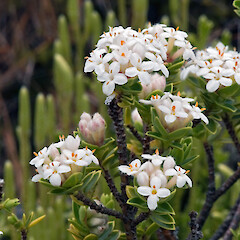Pimelea gnidia
Common name
pimelea
Synonyms
Banksia gnidia J.R.Forst. et G.Forst.; Passerina gnidia L.f.; Cookia gnidia J.F.Gmel.; Pimelea gnidia var. menziesii Hook. f.; Pimelea crosby-smithiana Petrie
Family
Thymelaeaceae
Flora category
Vascular – Native
Endemic taxon
Yes
Endemic genus
No
Endemic family
No
Structural class
Trees & Shrubs - Dicotyledons
NVS code
The National Vegetation Survey (NVS) Databank is a physical archive and electronic databank containing records of over 94,000 vegetation survey plots - including data from over 19,000 permanent plots. NVS maintains a standard set of species code abbreviations that correspond to standard scientific plant names from the Ngä Tipu o Aotearoa - New Zealand Plants database.
PIMGNI
Current conservation status
The conservation status of all known New Zealand vascular plant taxa at the rank of species and below were reassessed in 2017 using the New Zealand Threat Classification System (NZTCS) – more information about this can be found on the NZTCS website. This report includes a statistical summary and brief notes on changes since 2012 and replaces all previous NZTCS lists for vascular plants.
Please note, threat classifications are often suggested by authors when publications fall between NZTCS assessment periods – an interim threat classification status has not been assessed by the NZTCS panel.
- Conservation status of New Zealand indigenous vascular plants, 2017 . 2018. Peter J. de Lange, Jeremy R. Rolfe, John W. Barkla, Shannel P. Courtney, Paul D. Champion, Leon R. Perrie, Sarah M. Beadel, Kerry A. Ford, Ilse Breitwieser, Ines Schönberger, Rowan Hindmarsh-Walls, Peter B. Heenan and Kate Ladley. Department of Conservation. Source: NZTCS and licensed by DOC for reuse under the Creative Commons Attribution 4.0 International licence.
2017 | Not Threatened
Previous conservation statuses
2012 | Not Threatened
2009 | Not Threatened
2004 | Not Threatened
Brief description
Shrub to 1.5m tall with reddish twigs bearing pairs of bright green pointed leaves and hairy white flowers inhabiting higher rainfall upland (or sea level in deep south) areas from the Tararua Range to Fiordland. Leaves 5-35mm long by 2-7mm wide. Flowers to 5.5mm long. Fruit dry, enclosing black seed.
Distribution
Endemic. New Zealand: North (southern third), and South Island (westerly from Nelson to Fiordland)
Habitat
Coastal and lowland (southern part of range only) otherwise montane to subalpine. On rock, rock debris, leached acidic mineral soil, and peaty loam in open forest, forest margins and scrub on stream margins, landslides, valley heads, moraines, heathlands, burnt forest areas.
Detailed description
An erect to suberect much-branched shrub up to 1.5 m tall (reduced in stature on exposed sites and poor soils). Branches and branchlets ascending, glabrous or sparsely hairy at leaf axils and hairy on receptacles; internodes usually short. Node buttresses, brown or black, occupy the whole internode and may be prominent after leaf fall; internodes 2–7 mm long. Bark ages to grey. Leaves decussate, ascending, later sometimes patent or deflexed, often imbricate, on petioles 1–3 mm long. Lamina pale to medium or olive green, coriaceous, elliptic, ovate or sometimes oblong, obovate or lanceolate, 5–35 × 2–7 mm, keeled, acute, blunt-pointed or slightly apiculate, base cuneate. Margins thickened, slightly down-turned; midvein prominent abaxially, sunken above; lateral vein pattern camptodromus but not clearly evident; stomata only on under side. Inflorescences few to many-flowered, pedicels 1–2 mm long, persistent. Involucral bracts 4, similar to leaves but usually wider. Plants gynodioecious. Flowers hairy on outside; inside hairless, fragrant, white or flushed rose, sometimes wholly pink often with lower tube red. Calyx lobes open in salverform fashion. Female tube to 5.5 mm long, ovary portion 3 mm, calyx lobes 3.5 × 1.8 mm. female tube to 9 mm long, ovary portion 3.5 mm, calyx lobes 3.2 × 1.8 mm; staminodes short, at mouth of tube. Anther filaments inserted below mouth of tube; anthers yellow. Ovary with short hairs at summit and to about half-way down. Fruits ovoid, green, drying brown, 4 mm long. Seeds ovoid 3.4 × 1.6 mm. The dried hypanthia disperse with fruits inside.
Similar taxa
Very close to P. longifolia (it could be considered an upland form of that species) from which it differs by its smaller leaves, shorter flowers and preference for mostly subalpine habitats. Pimelea gnidia is only coastal in the southern part of its range where P. longifolia is not known. Both species are said to frequently hybridise (see Burrows 2008).
Flowering
October - January
Flower colours
Red/Pink, White
Fruiting
December - April
Propagation technique
Fickle. Can be grown from cuttings, and occasionally seed germinates in garden conditions. Does best in full sun on a well drained soil. However, even well established plants are prone to sudden collapse.
Etymology
pimelea: Pimeleoides means “resembling Pimelea’’, a genus in the family Thymelaeaceae (Greek, -oides = resembling, like).
gnidia: Named after the genus Gnidia which is also in the Thymelaeaceae family. Gnidia is named after Gnidus, a town in Crete.
Where To Buy
Not commericially available.
Taxonomic notes
Pimelea crosby-smithiana previously regarded as a distinct species is now regarded as part of the natural variation of P. gnidia.
Attribution
Description based on Burrows (2008).





